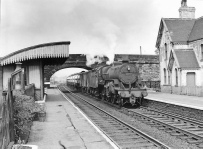



Old photographs depicting rail & road transport in Long Preston
can be seen in the Transport Photo Gallery.

The Development of the Railway
The following is extracted from the booklet
Celebrating 160 years -
Little North Western Railway in Long Preston
By Kathleen Jenning
Published by the Long Preston Heritage Group
The development of rail transport in the middle of the 19th century greatly affected the lives of people in Craven. Communications for the first time were fast and cheap, with the cost of rail fares being only a fraction of the cost of coach fares.
The first railway line was opened in this area by the North Western Railway in 1849 and was known as the “Little North Western”. It ran between Leeds and Lancaster. All the buildings along this line were constructed in Tudor style (wood and plaster), unlike the buildings on the later Settle-
Although the impact of the railways was more significant for the development of Hellifield, the opening of the “Little North Western” did lead to physical and social changes in Long Preston. The physical changes can be seen in the new building that took place, including public buildings such as the Mechanics Institute (1860), the Auction Market (late 1880s) and also the Conservative Club. All were built in a grander style, influenced by access to external designs and materials (eg blue slate brought from Cumbria on the railway). New housing was also built on the main road in Long Preston, at West End and at Pendle View and Ribble Terrace. These houses reflect the Victorian design, with greater height, different window details and the use of cut stone.
Social changes also took place as people from outside the immediate area came to live in Long Preston. The 1851 census records 9 heads of households having work associated with the railway, including the station master who had been born in Carnforth. Towards the end of the 1830s, there had been a decline in the numbers of people employed in the handloom weaving industry and it would seem that the houses left vacant as a result were occupied by the railway workers.
The railway was a very important link for the Dales farmers who could then obtain manufactured goods from both Lancashire and the West Riding by rail and could also send their produce to both areas the same way. At the beginning of the 20th century trains were the main form of transport for cattle. Almost every station had its own cattle dock on a siding off the main line, which was very important if the village had its own auction mart, as was the case in Long Preston and Hellifield.
The dock at Long Preston was situated about 100 metres immediately south of the station, large numbers of sheep and cattle would arrive and depart from the cattle dock in special cattle trucks on auction day. Animal feeds such as sugar beet were transported from Lincolnshire to Towler’s farm on School Lane (now May Barn). Wool was sent to Bradford. Coal used to be brought by train from the Yorkshire collieries to a special siding at Long Preston for Fred Jackman's coal business in the village. There was a station master and three porters at Long Preston station when the cattle dock was used regularly.
An additional set of sidings was constructed at Long Preston in 1919 for the new Fylde waterworks situated between Wigglesworth and Slaidburn. The necessary materials for the construction of Stocks Reservoir were all brought by train to Long Preston. Plans were put forward for the construction of a special branch line from the L.Y.R. to go directly to Stocks but it was decided the proposal would be uneconomical. Finally, it was decided to transport the materials by road from Long Preston to Tosside.
The station buildings at Long Preston were demolished in the 1970s. Whilst the work was underway, a bundle of old Way Bills for Miscellaneous Traffic sent by Passenger Trains was found. The Way Bills were tied together with a piece of string and on closer inspection were found to be the Way Bills for a complete week in 1904.
A description of the goods is given and their destination. These were used by Kathleen Jennings to provide a fascinating analysis of the type of goods and their destination.
The booklet can be ordered though the Publications Page or purchased at any of the Long Preston Heritage Group events.

More of the way bills
can be seen here:
Other documents
relating to the railway in
Long Preston are here:
Photographs of the station,
staff and engines are here:


Railway Exhibition on Saturday & Sunday 4th & 5th July 2009
To commemorate the 160th anniversary of the railway coming to Long Preston the Heritage Group arranged an Exhibition of the History of Long Preston Station, which was opened in July 1849.
The exhibition featured a large, detailed model 'O' gauge of the station and sidings as they were in the 1920's, together with working model engines and rolling stock of the period. There were also displays of photographs and documents showing the history of the railway.
More details of the Exhibition can be seen here.
Railway Station Model Comes Home
The owner of the model has dismantled it to start on a new model of Lancaster Green Ayre Station, and has kindly donated to the village the central part of the Long Preston model, depicting the station. The Village Hall Committee agreed to this being permanently installed in the Village Hall.
The unveiling ceremony was held on Friday 1st April 2011 and a Coffee Morning on Saturday 2nd to show off the model in it’s new location, together with display boards about the history of the railway.
Photographs of the unveiling and the coffee morning can be seen here.
Long Preston Station in 1931

Sheep on way to the cattle dock
Click on the images below to see a larger version: